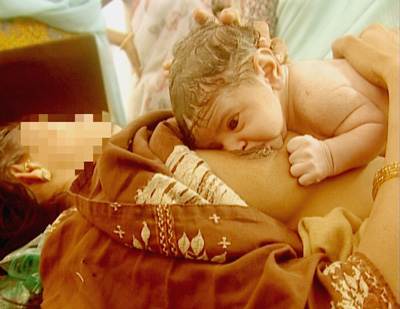English |
French |
Hindi |
Italian |
Marathi |
Spanish

UNICEF, WHO and WABA along with the scientific community strongly recommend initiating breastfeeding within an hour of birth. Evidence shows that early initiation can prevent 22% of all deaths among babies below one month, in developing countries. However, the scientific community has not widely recommended any specific method of initiation of breastfeeding. In the current scenario, the prevalent rate of under-nutrition in young children is a high 46 %, in India, according to 3rd National Family Health Survey (NFHS
III). This coupled with high morbidity and mortality, led to a felt need, in Maharashtra (India), for the identification of an evidence–based, workable method which is easy, replicable and cost effective.
It is also known that even human babies can initiate breastfeeding on their own, like the young ones of the animals, provided they are kept in skin-to-skin contact between their mother's breasts. This is known as the 'Breast Crawl'. The Government of Maharashtra, Nutrition Mission, ICDS (Integrated Child Development Services) and BPNI (Breastfeeding Promotion Network of India) Maharashtra, jointly with UNICEF have initiated an ambitious programme to train government / NGO functionaries in the basics of IYCF (Infant and Young Child Feeding). The miracle has moved one and all, from grass-root health workers to the highest bureaucrats and they have accepted it as the answer for early initiation of breastfeeding.
Soon after delivery and after the baby has cried and started breathing well
- The baby should be thoroughly dried (except for the hands) with a soft cotton cloth.
- Hands must be properly washed with soap and water before touching the baby.
- Then the baby is to be shown to the mother and kept close to her and held briefly in cheek-to-cheek contact. This enables the mother to kiss the baby and also facilitates the custom of saying a holy message in the baby's ear.
- The baby is then placed prone in between the mother's breasts. The baby and the mother's chest are both naked, so that the baby has full skin-to-skin contact with the mother. The baby and the mother should be covered together with a cloth, so that they keep warm while continuing with skin to skin contact.
- Care should be taken to prevent the baby from falling.
- The baby is very alert and responsive soon after delivery and hence is at her best instinctive level.
- The baby is kept warm by being in skin-to-skin contact with the mother. Touch is also a strong stimulus for neurodevelopment.
- The baby's risk of infection is reduced because safe germs (bacteria) from the mother start to colonise her skin and intestines, and prevent harmful germs from growing.
- This position ensures early instinctive stimulation and gives warmth, love, security and food. It also initiates the bonding process between the baby and the mother.
- Whenever possible, raise mother's head on a pillow to facilitate mother-baby visual contact.
- Kicks from the baby will give tender firm jerks to the womb stimulating it to contract. This will help to expel the placenta and reduce bleeding.
- Once the baby realizes that food is in close proximity, she starts salivating.
- Breast odour is a strong stimulus which drives the baby toward the nipple. The baby's sense of smell is well developed. The odour of a substance secreted by the nipple is similar to the smell of a substance in the amniotic fluid which surrounds the baby in the womb.
- Nipple Massage by the baby makes it protract. This helps attachment. Nipple massage also releases a hormone called oxytocin in the mother. This helps to contract the uterus, reduce bleeding and prevent maternal anaemia.
- The baby starts to make mouthing movements. The baby's hands should have amniotic fluid on them, as it guides the baby to the nipple.
- The baby's shoulder, hip and neck muscles are sufficiently developed to help her move.
- Even with her limited vision, the baby can see the areola. If the baby raises her head, she can also see her mother's face.
- The baby then reaches the nipple, raises her head and gets nicely attached onto the nipple with her mouth wide open to take a mouthful of breast.
- This first skin-to-skin contact must continue until the baby finishes her first breastfeed.
What a beautiful moment of joy, for the mother and the child! This baby has reached its destination in just over 10 minutes. The majority of babies will successfully complete the Breast Crawl in about 30-60 minutes.
Like all other gifts of nature this gift comes free of cost. However, the health and nutrition benefits offered will save millions of lives and will save billions in terms of health cost. They will create a generation which will reach the highest human potential of growth and development.
We request you to carry this message to all future mothers and their families to prepare them to experience this miracle. Train every health worker in the maternity service to help every baby and mother to initiate breastfeeding, the nature's way.
